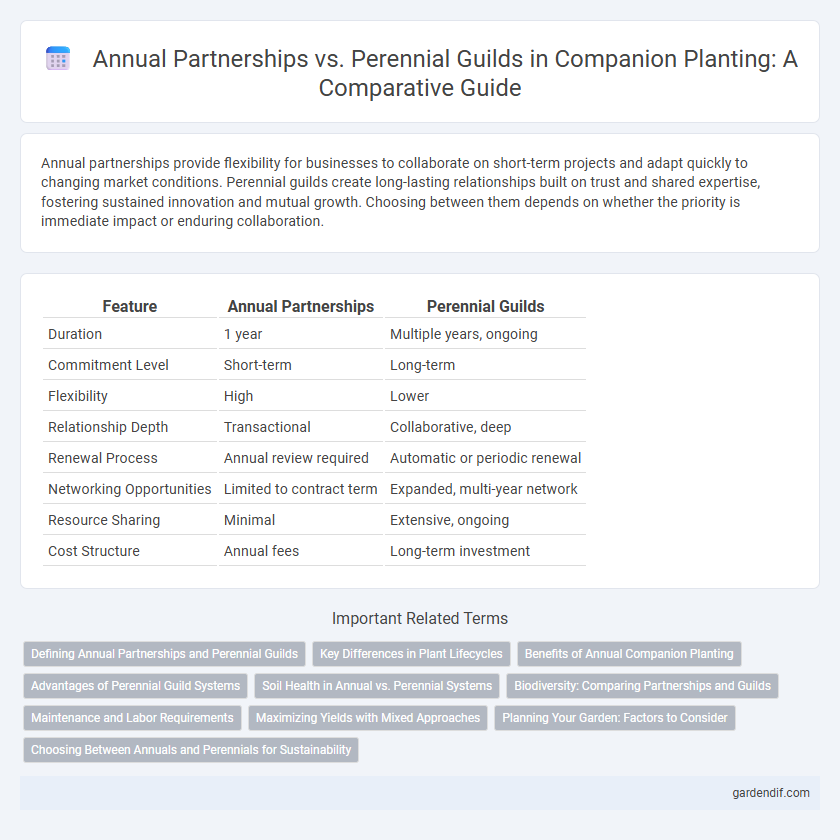
Annual partnerships vs perennial guilds Illustration
Annual partnerships provide flexibility for businesses to collaborate on short-term projects and adapt quickly to changing market conditions. Perennial guilds create long-lasting relationships built on trust and shared expertise, fostering sustained innovation and mutual growth. Choosing between them depends on whether the priority is immediate impact or enduring collaboration.
Table of Comparison
| Feature | Annual Partnerships | Perennial Guilds |
|---|---|---|
| Duration | 1 year | Multiple years, ongoing |
| Commitment Level | Short-term | Long-term |
| Flexibility | High | Lower |
| Relationship Depth | Transactional | Collaborative, deep |
| Renewal Process | Annual review required | Automatic or periodic renewal |
| Networking Opportunities | Limited to contract term | Expanded, multi-year network |
| Resource Sharing | Minimal | Extensive, ongoing |
| Cost Structure | Annual fees | Long-term investment |
Defining Annual Partnerships and Perennial Guilds
Annual partnerships typically involve collaborations that last for a single year, centered around specific goals or projects with clear start and end points. Perennial guilds consist of ongoing, long-term alliances focused on continuous mutual support, knowledge sharing, and collective growth within a community. Defining these entities hinges on their temporal scope and the nature of their collaborative commitments, with annual partnerships emphasizing time-bound objectives and perennial guilds fostering sustained relationships.
Key Differences in Plant Lifecycles
Annual partnerships involve plants that complete their entire lifecycle--from germination to seed production--within a single growing season, requiring replanting each year. Perennial guilds consist of plants with lifecycles extending multiple years, enabling continuous growth, regeneration, and ecological stability. Understanding these distinctions in plant lifecycles is crucial for optimizing companion planting strategies that align with seasonal timing and resource availability.
Benefits of Annual Companion Planting
Annual companion planting enhances soil health by promoting nutrient cycling and reducing pest populations within a single growing season. It allows gardeners to adapt crop combinations yearly, optimizing yields and maximizing space efficiency through diverse plant interactions. Fast-growing annual companions also improve microclimates, increasing overall garden resilience and productivity.
Advantages of Perennial Guild Systems
Perennial guild systems offer sustained collaboration and knowledge sharing that annual partnerships often lack, fostering long-term innovation and resilience among members. These guilds create stable networks that enhance skill development and resource pooling across seasons, driving continuous improvement and adaptability. Their enduring structure supports stronger trust and collective identity, resulting in more efficient problem-solving and sustained competitive advantage.
Soil Health in Annual vs. Perennial Systems
Annual partnerships often involve crop rotations that disrupt soil structure yearly, promoting nutrient cycling but risking erosion and organic matter loss. Perennial guilds, with deep-rooted plants and minimal soil disturbance, enhance soil aggregation, carbon sequestration, and microbial diversity, leading to sustained soil health. Integrating perennial species within annual systems can optimize soil resilience and productivity by combining rapid nutrient uptake with long-term soil stabilization.
Biodiversity: Comparing Partnerships and Guilds
Annual partnerships contribute to biodiversity by fostering seasonal interactions among species that adapt quickly to environmental changes, enhancing ecosystem resilience. Perennial guilds maintain stable, long-term relationships among species, supporting consistent resource use and habitat structure critical for sustained biodiversity. Comparing these, annual partnerships drive dynamic species turnover, while perennial guilds ensure ecological balance through enduring cooperative networks.
Maintenance and Labor Requirements
Annual partnerships demand consistent, high-intensity maintenance and frequent labor input to sustain short-term goals, often leading to resource strain. Perennial guilds benefit from established workflows and shared responsibilities, significantly reducing ongoing labor efforts and maintenance costs through long-term collaboration. Efficient allocation of personnel and systematic upkeep in perennial guilds enhances operational stability compared to the fluctuating demands seen in annual partnerships.
Maximizing Yields with Mixed Approaches
Annual partnerships offer agility and targeted results within a single growing season, while perennial guilds provide long-term soil health and consistent yields through ecological balance. Combining both strategies maximizes agricultural productivity by harnessing the immediate benefits of annual plants alongside the sustainable resilience of perennial systems. This mixed approach enhances nutrient cycling, pest management, and overall ecosystem stability, optimizing yield potentials year after year.
Planning Your Garden: Factors to Consider
When planning your garden, understanding the dynamics of annual partnerships versus perennial guilds is crucial for sustainable growth and soil health. Annual partnerships involve planting complementary species that complete their life cycle each year, facilitating crop rotation and reducing pest buildup. Perennial guilds, on the other hand, consist of long-term plant communities that support each other through nutrient sharing and layered growth, enhancing biodiversity and resilience over multiple seasons.
Choosing Between Annuals and Perennials for Sustainability
Annual partnerships provide short-term collaboration opportunities, allowing for flexibility and adaptation in rapidly changing markets. Perennial guilds foster long-term relationships that enhance trust, resource sharing, and sustainability through continuous collective growth. Selecting between annuals and perennials depends on strategic goals, with perennials supporting enduring impact and annuals enabling agile responses.
Annual partnerships vs perennial guilds Infographic

 gardendif.com
gardendif.com